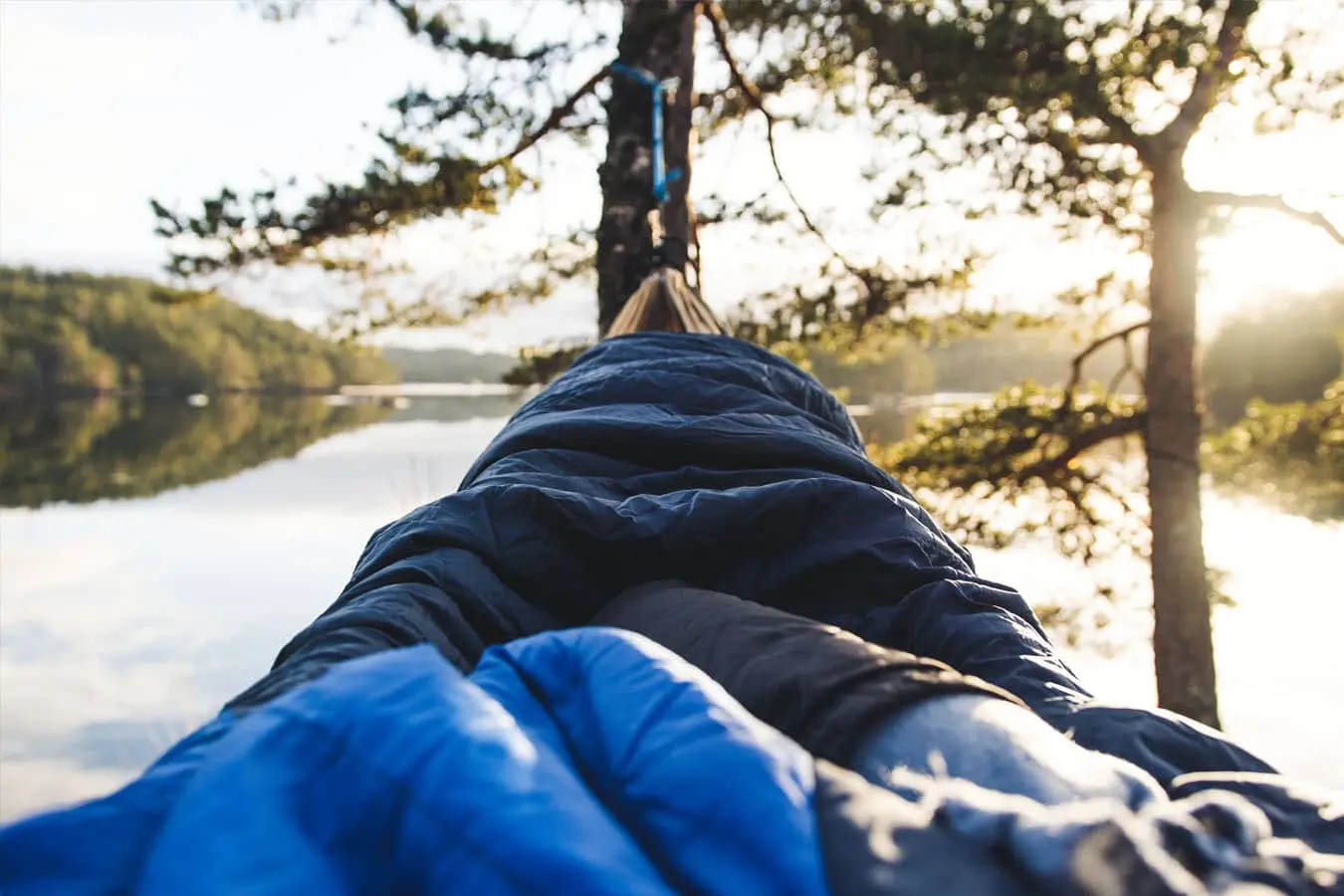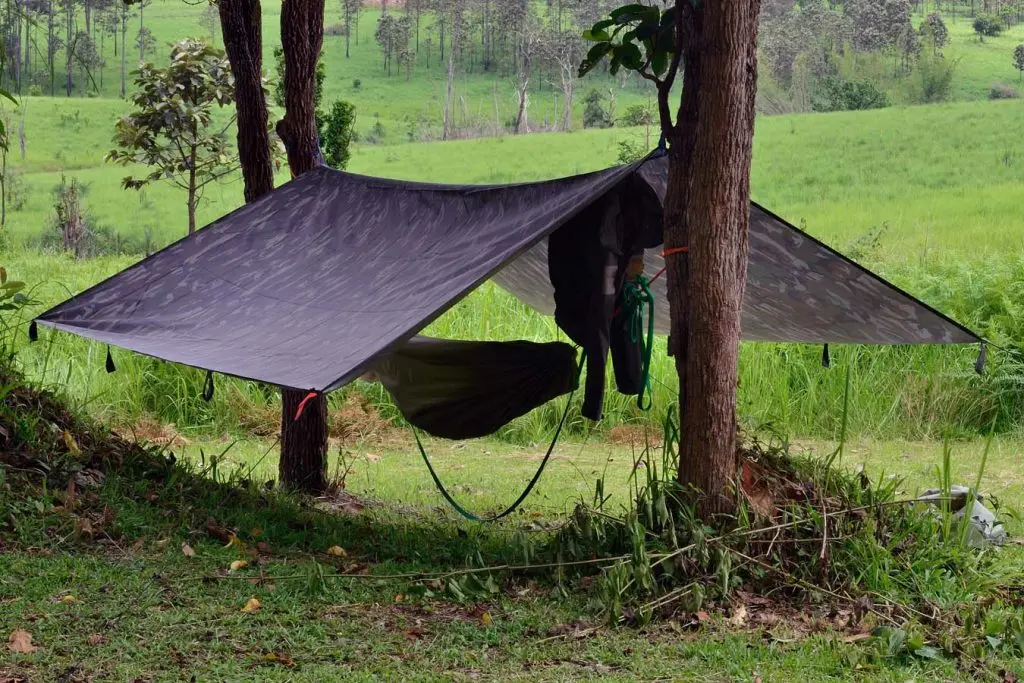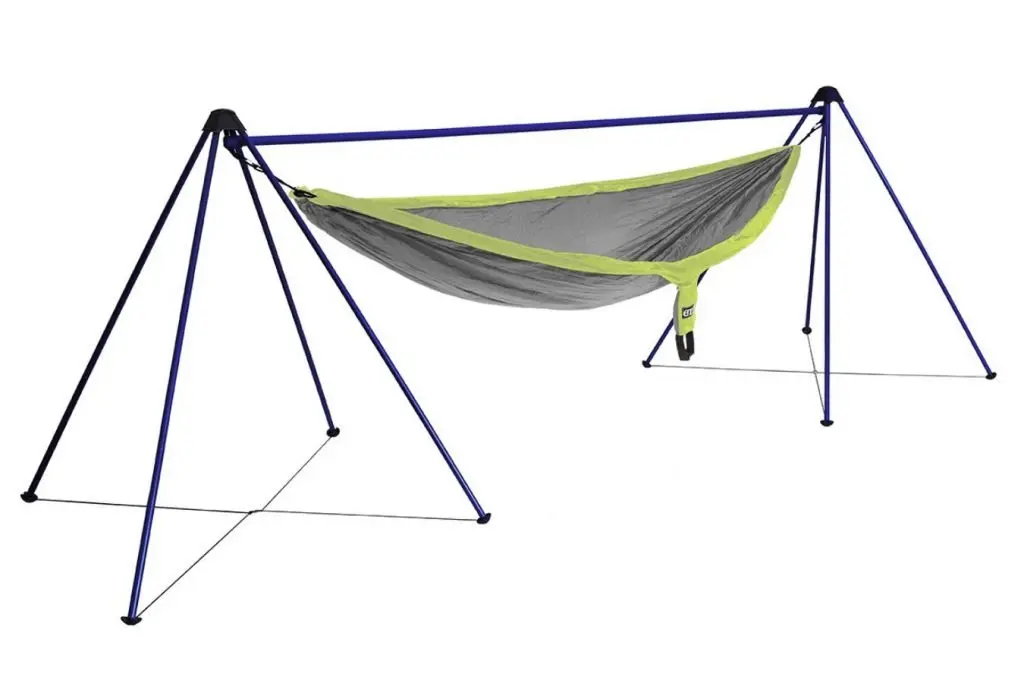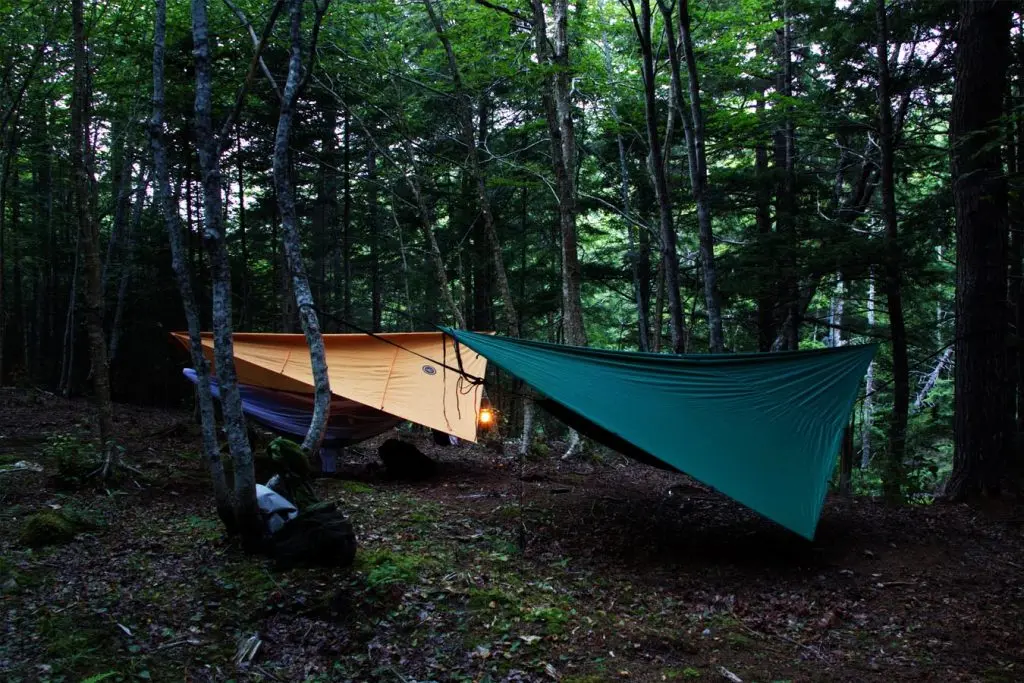When you set out on your very first hammock camping trip, it’s important to keep in mind that this style of camping can be a little more technical than your average tent.
You’ll want to make sure you are well prepared. For example, are you going to a hammock-friendly campsite? Do you have proper gear? Do you need a sleeping bag with a hammock?
Asking yourself these questions goes a long way in setting you up for either a successful or failed attempt at hammock camping. Read more below to find out if sleeping bags or its alternatives are the better companion for a good night’s sleep under the stars.
Why You Might Need a Sleeping Bag in a Hammock
Hammock camping means sleeping outside. While you’re not on the cold hard ground, the wind chill can be unbearable if you’re not well-equipped.
So do you always need a sleeping bag in a hammock or not?
As a rule of thumb, you won’t need a sleeping bag for your hammock unless the nightly temperature drops below 70 degrees Fahrenheit (or about 21 degrees Celsius). Any temperature above 70 degrees and you should be clear.
But that’s not the only thing to consider when deciding if you should use a sleeping bag in a hammock.
Don’t forget other factors, such as wind chill, which can often make it feel colder than the temperature displays. There have even been instances of people sleeping in hammocks on the beach that have gotten cold at night due to a chilly breeze coming off the ocean.
So, why is this? For one, it’s not just the temperature that impacts whether or not we feel cold in a hammock. As we sleep, our body temperatures drop too, making even considerably warm temperatures (i.e. 75+) feel a bit chilly.
In addition to temperature, you need to consider overall humidity. Remember, a wet night will result in a much colder night, too.
Moreover, while hammocks are meant for wild camping, they’re not meant to protect you against harsh elements. In fact, they do the opposite. Made from mostly nylon, hammocks detract heat and wick moisture, allowing for air to pass through freely in order to keep our bodies cool and fresh during a hot summer day.
So if your intention is to sleep comfortably and warmly at night, you might indeed need a sleeping bag in your hammock.
Sleeping Bag Alternatives
You may think that taking a sleeping bag is all you need to stay warm in a hammock. But that’s not the case. Sleeping bags have varying levels of thickness.
However, while most keep you warm in normal situations, your body’s weight in a hammock compresses the sleeping bag down causing it to be thin. As a result, the back of your body is exposed to the cool air rising up and seeping into your hammock.
To prevent this from happening, you should consider using a sleeping bag alternative (or at least, combine it with another layer of protection). The most popular choice is a hammock underquilt which actually encircles you around the hammock from one end to the other.
Underquilts are great sleeping bag alternatives because they keep cold air at bay while preserving your body’s natural heat inside. They usually are made with lightweight and cozy down or synthetic insulation which gives them the added advantage of acting as an extra cushion to evenly spread out your body weight.
Both types of underquilts are pricey, but if you’re serious about hammock camping then investing in an underquilt will be worth the price tag.
Another sleeping bag alternative is a top quilt. However, top quilts aren’t nearly as popular as underquilts on their own because their purpose is less obvious.
You would really only need a top quilt if you were going winter hammock camping to provide additional insulation. That said, they’re usually used in combination with an underquilt.
With both underquilts and top quilts, you can hammock camp in temperatures ranging from 0-50 degrees Fahrenheit! When finding an underquilt or top quilt, look for the “seasons ratings.” Season one is for warm summer trips while seasons three and four are for fall and winter hammock camping.
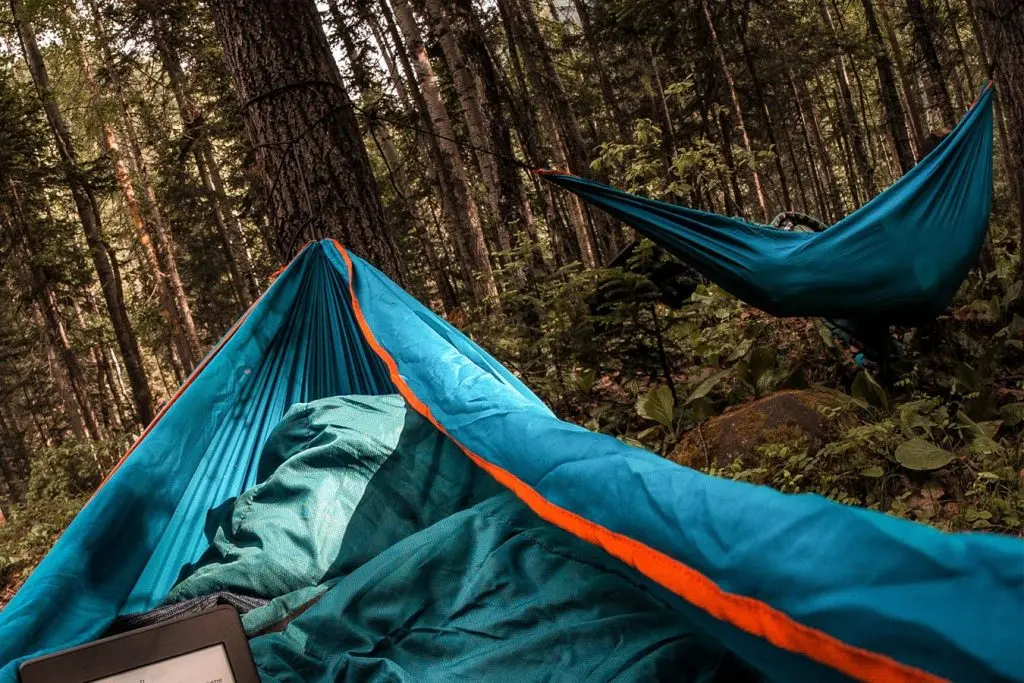
Sleeping Bags vs. Quilts
The sleeping bag vs. quilt debate is an ongoing topic in the outdoors world. So we’ll present you with the pros and cons of both and let you decide!
Sleeping bag advantages & disadvantages
Sleeping bags are iconic of the camping lifestyle. On the surface, there’s hardly anything you could criticize about a sleeping bag. But when you are an active camper, you begin to realize sleeping bags aren’t all that perfect.
Here are the main pros and cons of using a sleeping bag with a hammock.
Sleeping Bag Pros
- They pack up nicely and are easily portable for hiking and camping
- Sleeping bags get the job done at keeping you cozy at night
- Versatile and flexible to suit your level of adventure
Sleeping Bag Cons
- They aren’t ideal for hammock camping as they compress and slip in the hammock
- Limits free movement (claustrophobic)
- Not ideal for sharing or cuddling!
Sleeping bags will always have their perks, but they aren’t so awesome for hammock camping; they slip and slide in the hammock and the insulation compresses down, thus failing at retaining heat.
Hammock quilt advantages & disadvantages
So is using a quilt with a hammock better? Quilts are generally revered as the better hammock sleeping option because they offer an extra layer of comfort whereas sleeping bags lose their insulation. However, quilts do require more set up time and a little technical know-how.
Here are the pros and cons to this choice of hammock bedding.
Quilt Pros
- Traps in heat around you without being directly on top of/below you
- Allows freedom of movement inside the hammock so you don’t feel trapped
- Is adjustable, versatile, and shareable so you can use with a partner
Quilt Cons
- An additional (and pricey) expense to add to your camping gear
- Down quilts lose their function when they become wet
- More hassle to install
There will always be people who prefer sleeping bags over quilts and vice versa. But what’s certain is there has been a recent trend among campers preferring hammock quilts.
They both have their advantages and disadvantages–so deciding which one is better will ultimately depend on your needs and lifestyle.

Other Hammock Sleeping Options to Keep You Warm
Not liking either sleeping bags or quilts? Then you might still have some wiggle room when it comes to choice.
1. Line your hammock with a sleeping pad
Sleeping pads are another hammock sleeping option that will keep you both warm and comfortable. There are both foam and inflatable styles of sleeping pads, but both will do the trick of protecting you from getting what’s known as ice butt, or cold-butt syndrome (when you wake up shivering because the cold seeped in).
Sleeping pads aren’t the best alternatives to sleeping bags as much as they are complementary to them. With this said, it’s best to use them together.
2. Cover yourself with a rain fly
An additional way to keep yourself warmer at night while sleeping in a hammock is to use a rain fly. Rain flys aren’t meant to insulate you, but they do help in keeping you dry which contributes to your level of warmth.
While rain flys mean packing an extra camping accessory, it’ll be worth it even if it prevents only the fine morning dew from lining your hammock.
3. When in doubt, grab your car’s sun shield
If by chance you forget to pack any sort of liner or source of warmth for your hammock, then just grab your car’s sun protector. If you don’t have one, check out the nearest gas station. They might stock them.
In any case, a sun protector or aluminum blanket will provide enough protection as a cheap sleeping pad alternative. It might not be as comfortable as an insulated pad or quilt, but it will ensure an extra layer of warmth to get you through the night. This isn’t a long-term solution by any means, but it’ll get the job done.
4. Wrap your sleeping bag around the hammock
As a last result, you could always use your sleeping bag and turn it into a “DIY” hammock quilt by stringing your sleeping bag around your hammock and tying off the ends to keep it in place.
This technique won’t be a fix-all solution but it will certainly help in providing you more space while retaining in your body heat throughout the night.
FAQS
Do you need a sleeping bag with an underquilt?
When you have an underquilt already, do you actually need a sleeping bag? That depends on the level of warmth you desire. Underquilts prevent cold from rising up from the underside, but you’ll still likely want something to cover you on top.
It doesn’t have to be a sleeping bag. It could be a blanket or even just your warm clothes.
Does a sleeping bag take the place of a top quilt?
A sleeping bag doesn’t quite replace a top quilt, but unzipped they can work as a temporary top quilt alternative. Top quilts are much lighter and packable, and when combined with an underquilt, keep you much warmer without the restriction from a sleeping bag.
Can I use a sleeping bag as an underquilt?
If you only have a sleeping bag, you could try to use it as an underquilt by wrapping it around the outer shell of the hammock. This isn’t an easy option, but it’s doable. You will need to zip the hammock underneath and around the hammock and rezip.
The trouble is this method often leaves gaps in airflow around the feet and head, so experienced campers recommend tying off the ends to prevent both slippage and air from entering.
Conclusion
While sleeping bags have been common camping practice for decades, they are not necessary for sleeping in a hammock. There are better alternatives to sleeping bags out there, such as underquilts and top quilts, but it depends on your preference, budget, and lifestyle.
However, if you’re out camping and you have no other options to keep warm, you can still use a sleeping bag with a hammock to use as a DIY quilt or simple top quilt (when unzipped). Ultimately, the choice of whether or not to use a sleeping bag with a hammock depends on your needs.
But know there are solutions to sleeping in a hammock without a sleeping bag that work–and work well!
Related guides
How To Hammock Camp As A Couple

